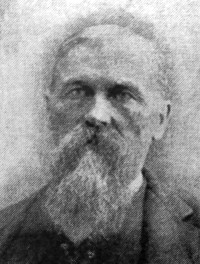By extending the 1881 map on page 4 farther north, William Silver's original 160-acre homestead in the southwest corner of Section 33 can be seen. Silver came from Ohio and made his claim in 1858, possibly making him the first settler in the Morganville area. Carson identifies settlers Jacob Miller and Lars Anderson as the next to arrive. Their homesteads are in Section 27.
Settler William Silver
Who was here before the Morgans?
Who was first upon the scene?
William Silver was the first one.
Jacob Miller was the next.
Gertrude Miller is our symbol.
Then Lars Anderson arrived.
These you see are now the oldest
Live descendants in our midst.
Back in 1858 with forty dollars and some change,
Young Bill Silver staked his claim
Twenty miles from any neighbor,
Thirty miles from Indian camping.
Still young Silvers learn their primers;
Still the Silvers harvest wheat.
Is it still a thousand acres?
Where a flail once did the threshing,
Where the chaff was blown by shaking.
Listen, neighbor town in France,
We began by simple hardship;
We had neither seeds nor houses.
Only prairie sod and work hands.
Then the Edelblutes and Vincents
And the Raridans and Hayes
And the Mertens and the Malcolms
Found their destiny with Silvers,
Brought their gifts to Morganville.
Comment
Morgan did not arrive in an uninhabited place, but found settlers William Silver, Jacob Miller and Lars Anderson had
arrived earlier.
Gertrude was Jacob Miller's daughter.
William Silver was apparently the first white settler at what became Morganville. An 1890 biography stated that
he arrived with $42.
The flail - two sticks connected by a rope - was used to beat wheat kernels, breaking away the husk covering. Tossing
the beaten wheat into the air allowed the wind to blow the lighter husks - chaff - away, leaving just wheat.
Life was a struggle, but soon others came, bringing their culture, customs, talents and heirlooms.
William Silver was born in Ohio in 1832 and came to Kansas in 1857. In 1858, he filed a pre-emption on the southwest
quarter of Town 6 Range 2 of Section 33 in Clay County, Kansas. This meant the land would not have to be paid for
until someone else wanted to buy it. Silver worked in Riley County, Kansas in 1858 and traveled to Pike's Peak in
1859, returning to his claim in 1860.
He enlisted in the Union Army in 1862, married Lucinda Edelblute of Keats, Riley County, Kansas, the following year. With the
conclusion of the Civil War, the couple settled on his claim. They had two boys and two girls. In 1879, he moved
to the village, which was briefly named Silver in his honor, but later renamed Morganville. He died in 1911.
William Silver
Could we pause for one short story,
One about our daily bread?
It's about the young Lucinda,
William's bride of long ago.
She was baking bread for many,
Huge dish pans of dough and yeast,
All alone in her small cabin,
Twenty miles from anyone.
When a courier stopped to warn her;
When a rescuer came by,
Saying Indians were returning.
She must run and hide or die.
Young Lucinda grabbed her bonnet;
Rode off on a running horse.
Left the rising bread forgotten;
Two huge batches in the warm place.
When the Indians moved some place,
She returned to meet her bread,
Coming toward her in the pasture.
It had risen from the dish pans,
It had crawled down from the stove.
It had flowed across the cabin,
It had found the open holes.
It had started out to find her,
Hitching posts stood deep in dough.
How she scraped her house and cleaned it,
Every Silver child must know.
Probably lore passed down in the Silver family, amplified over time, yet possibly retaining a kernel of truth.
Lucinda (Edelblute) Silver, William's wife, is alone in their small cabin when a rider warns of Native Americans
nearby. She is in the process of making bread, but must flee. When she returns, the yeast in the bread dough
has caused the dough to rise to where it fills the cabin and pushes out through the door.
In reality, a maximum expansion would increase the dough size by a factor of two or three past the normal baking
size before the gluten would break, reducing the mixture to a sticky mess.
Lucinda cleaned every part of the cabin and every Silver child would know the story.



